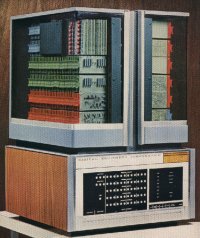IBM System/360 Computers (1960s)
In 1964, after investing $5 billion, IBM made a bold move with the announcement of the System/360 with various models. The clock rate, range of memory sizes, and approximate price for only the processor and memory of average size of the four models are given next:
|

|
Adding I/O devices typically increased the price by factors of 1.8 to 3.5. IBM bet its company on the success of a computer family, and IBM won. The System/360 and its successors dominated the large computer market. The IBM System/370 was a model range of IBM mainframes announced in 1970 as the successors to the System/360 family.
| In 1965, Digital Equipment Corporation (DEC) unveiled the PDP-8, the first commercial minicomputer, a computer smaller than a mainframe, but larger than a microcomputer. It was a breakthrough in low-cost design, allowing DEC to offer a computer for under $20K. DEC was acquired in 1998 by Compaq, which merged with Hewlett-Packard in 2002. |

|
|
My wife does this cute thing now and then where she goes out shopping for next year’s yard sale items. |